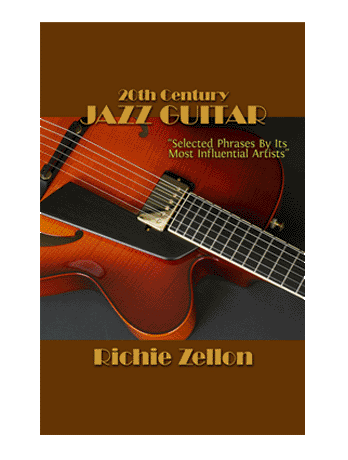Part 3: “How to incorporate your transcribed phrases in a solo”
Here you can download the examples demonstrated in Part 3 : Joe Pass 1 Joe Pass 1 with “diminuition” Joe Pass 1 with “truncation” Joe Pass 1 with “modal conversion” Joe Pass 1 with “mixed alterations’
To Part 4: Suggestions on How to Organize a 12 month Workout with This Series
The following is a transcription of Part 3:
Since many of you might not have the skills to properly organize the phrases you are learning in the context of a jazz standard, I am going to provide you periodically with some written etudes. How this is done is beyond the scope of this series and would require an in depth study. However I am going to explain briefly some of the techniques used in order that you have a better idea of the big picture.
1- We first must pick a jazz standard that we would like to use as a vehicle to develop our II-V-I phrases into a fully fledged solo. I recommend starting out with a tune full of major II-V-I’s such as “Tune Up” or “Satin Doll”. You can do this in regular notation or tab it out. Keep in mind that if you tab it out you need to notate the rhythms you are going to employ.
Some advanced players are able to practice this procedure entirely on their instrument without doing any writing. This of course requires that they have the music they are soloing over ,as well as the phrases they want to incorporate, both memorized. In addition it requires a good understanding of the fretboard, various fingerings, a strong background in harmony…and last but definitely not least, an excellent ear. I gather that the majority of players subscribed to this series don’t posses all of these attributes, so I’m going to proceed to briefly demonstrate a written solo I did using the chord progression to “Tune Up” by Miles Davis.
- Notate the chords to a full chorus of the chosen standard and perform a light harmonic analysis. Enclose all the II-V cadences in parenthesis while showing resolution with an arrow whenever the V chord resolves. I am assuming that you understand at least that much if you want to pursue this section. See Example 1
- Start filling in the cadences you analyzed with the phrases you have been practicing. In many instances this will require that you “adapt” a chosen phrase to fit the context of the tune. Most of the time you will have to transpose the phrase and work out an alternate fingering. Other instances will require that you shorten or expand a phrase. Frequently you will have to alter some notes in a phrase to fit a substitute chord.
In conclusion, we have to learn how to mold and shape a phrase both rhythmically and melodically. There are several ways this can be achieved. You can delete some of the notes in the phrase which is a procedure known as “truncation”. Other alternatives are “diminuition” which consists of decreasing the value of the original notes, or “augmentation” which consists of augmenting their value. By experimenting with these techniques you will come up with a wide variety of new phrases. Here are some examples of these techniques as applied to a II-V-I phrase by Joe Pass. (please watch video)(these examples can be downloaded below the video on this page for easier comparison)
- Write a minimum of 2 additional solos over the same standard’s chord progression using different phrases each time. The principle here is that we want to program in our playing not only new vocabulary but we also want to embed a map in our subconscious of alternative routes to get through those chord changes. One solo alone won’t do it. Our brains need store several ways of getting from point A to point B before we can improvise. As a matter of fact, the more solos we practice containing different vocabulary with varied fingerings, the better we will be able to navigate the chord changes when it comes time to improvise.
